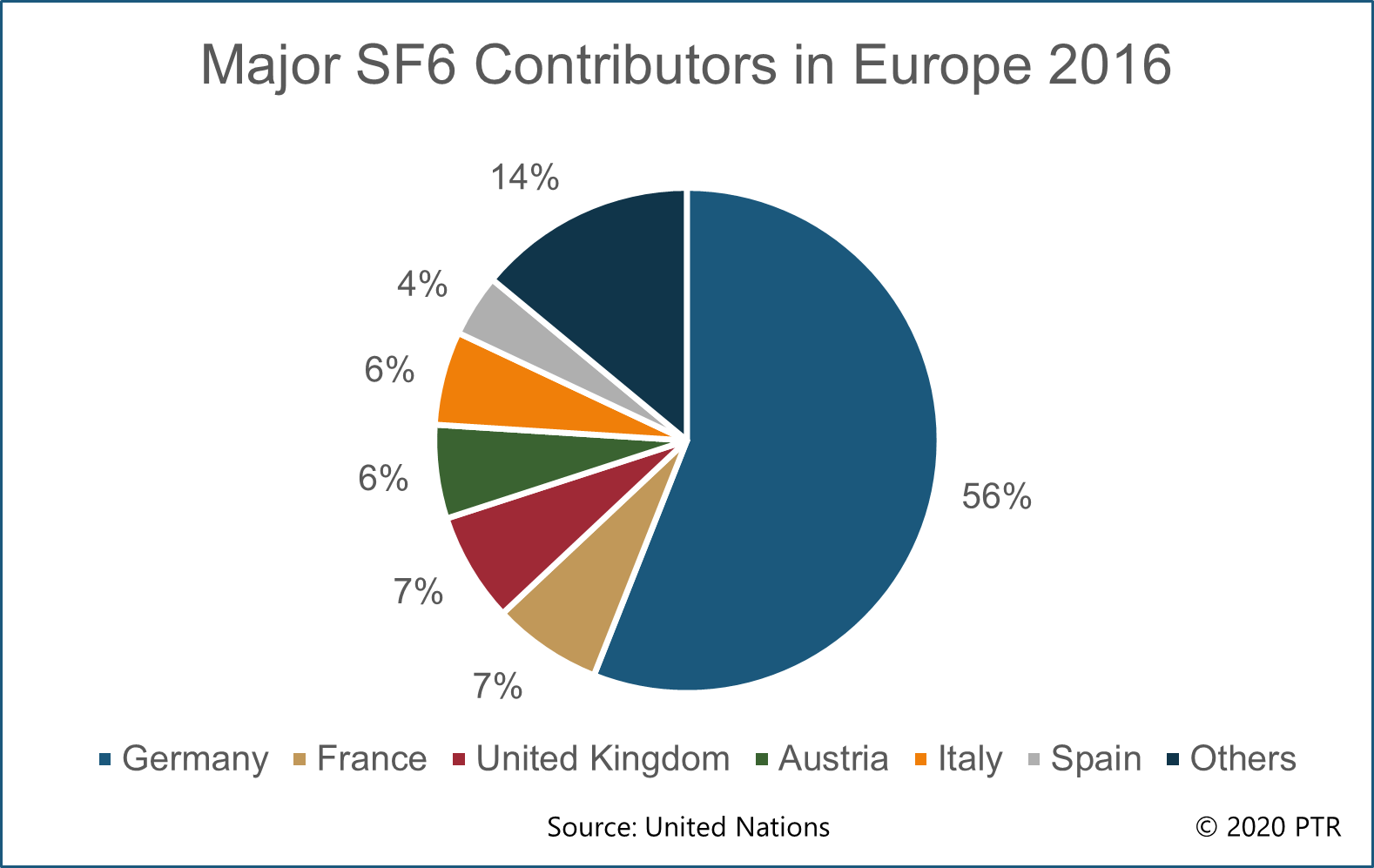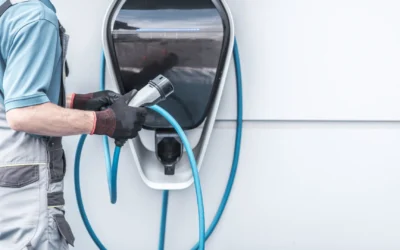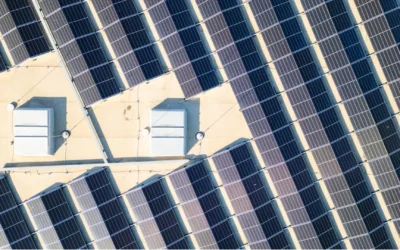Switchgear is an integral part of any modern power system, which is employed to control and regulate the flow of electricity in the circuit. Globally we are observing a growing trend to shift to SF₆ free switchgear, especially, in European Union. In this article we will be discussing the environmental impact of SF₆ gas, EU report on SF6 alternatives, market players providing SF₆ free switchgear and future prospects.
Environmental Impact of SF6
Sulphur hexafluoride (SF₆) is widely used in the electrical industry due to its extremely stable, non-flammable and highly electronegative characteristics. It is also radioactive in nature and a potent greenhouse gas. This colorless, odorless gas is not found naturally on earth.
SF6 is very efficient in absorbing infrared radiations especially in the wave number range 915-916 (cm-1) effectively increasing the average temperature of earth. One kilogram of SF₆ has a Global Warming Potential (GWP) of 23,500 times more than that of CO2. The figure below shows a variety of gases, both natural and man-made, with their GWP.
Where Greenhouse gases can be both man-made or naturally occurring for instance (H2O, CO2, CH4, N2O) or purely man made for instance fully fluorinated compounds FFC. Hence global warming has two main contributors: naturally occurring gas concentrations and anthropogenically generated compounds..

Figure 1: Greenhouse gases – GWP and lifetime in atmosphere.
Despite its tremendous global warming potential, SF₆ contributes only 0.01% to global warming of earth in contemporary times where unlike other pollutants there is no scientific evidence that SF₆ contributes to stratospheric ozone depletion. But the atmospheric life of SF₆ gas when calculated it was found to be in between 800-3200 years. Because of widespread use of SF₆ and its long atmospheric life it poses a long-term environmental threat. If SF₆ continues to produce and leak at the current rate, it is estimated that in 100 years its relative contribution to global warming would climb to 0.1%.
Although SF₆ contributes a small percentage to greenhouse gases, that percentage is growing due the widespread use of SF₆. An analysis of the atmosphere done in Alaska by NOAA in 2020, showed SF₆ to be 10 parts per trillion which is an increase of 108% from 2000 levels. A study by the University of Cardiff expects SF6 to grow by 75% by 2030.
In 2016, data from the U.S. Environmental Protection Agency estimates that emissions from manufacturing of electrical equipment are about 12 percent of the total SF₆ emissions, while installation of equipment combined with equipment operation and servicing accounts for 76 percent and retiring and disposing of the equipment accounts for the remaining percentage. Meanwhile the electrical company, Eaton, has shown that older switchgear can leak as much as 15% for the full life cycle of the product while newer switchgear have lower leak rates.
In 2017, SF₆ emissions in Europe were the equivalent of 6.73 megatons of CO2 which equals the greenhouse gas emissions for 1.3m cars for a year and this was an increase of 8.1% year over year.
Major SF₆ contributors in Europe and respective contributions are shown in the figure below:

Figure 2: Major SF6 contributors in Europe (2016).
Paris Agreement
The Paris Agreement was a landmark agreement with a global agenda to combat climate change. Following its announcement, the electrical industry has focused on playing its role in the reduction of carbon footprint. A greater push towards renewable energy sources was their natural response but fossil fuel-based electricity generation is not the only aspect of industry which has detrimental impact on the environment. Utilization of SF₆ in electrical switchgear also contributes to global warming and is a hazard specially in long term. In response to the threat along with other technological improvements, alternatives of SF₆ have been introduced in last few years subsequently ushering in an era of green switchgear. But despite the introduction of alternative technology, SF6 still remains the most widely used solution in the market.
European Commission F-gas regulations
To mitigate the emissions of fluorinated greenhouse gases and hydrofluorocarbons, European Union enacted two important pieces of legislation: F-gas regulation and MAC directive. The article-1 of the regulation sets the agenda of it.
Article 1:
The objective of this Regulation is to protect the environment by reducing emissions of fluorinated greenhouse gases. Accordingly, this Regulation:
(a) establishes rules on containment, use, recovery and destruction of fluorinated greenhouse gases, and on related ancillary measures;
(b) imposes conditions on the placing on the market of specific products and equipment that contain, or whose functioning relies upon, fluorinated greenhouse gases;
(c) imposes conditions on specific uses of fluorinated greenhouse gases; and
(d) establishes quantitative limits for the placing on the market of hydrofluorocarbons
The gas regulation became applicable on 1st January 2015 (replacing the original F-gas regulation adopted in 2006). As per the regulation, the EU will cut F-gas emissions by two-thirds by 2030 when compared with 2014 levels.
The MAC directive prohibits the use of F-gases with a global warming potential greater than 150 times of carbon dioxide in new types of cars and vans introduced from 2011 and in all new cars and vans manufactured from 2017.
Regulation (EU) 517/2014
This regulation maintains measures of the older regulation in particular to leak prevention, recovery, and selected restrictions on the use and marketing of F-gases. Article 21(4) of regulation requires the Commission to examine whether cost effective, technically feasible and reliable alternatives exist which make the replacement of fluorinated greenhouse gases possible in new medium voltage secondary switchgear.
The report focuses on medium voltage primary switchgear and higher voltage switchgear as well as generator circuit breakers and other related equipment. This report does not consider retrofitting.
Conclusions of EU Report
The report concludes that for new medium voltage switchgear using secondary distribution switchgear, SF₆ is currently the dominant technology to carry out both insulation and for circuit breaking. Some commercial alternatives for SF₆ have been available for certain applications up to 24 KV. Though manufacturers require time to develop comprehensive product range and install the required production capacity to serve the market needs.
The report predicts that various types of switchgear in the product range could become available around 2-5 years depending on how advanced the developing and testing is for each type of switchgear.
In some special cases it still will be difficult to replace SF6 because of special space requirements and environmental conditions. In addition, costs will be 5-30 % higher compared with conventional SF 6 insulation.
When it comes to circuit breaking, vacuum is the most common alternative for SF₆ gas, containing load break switches. Vacuum is technically feasible but obstacles in the way of wider uptake in secondary distribution is its need for maintenance. That along with complex and costly changes needed to curtail the risk of compromising the selectivity of protection system which makes sure that only related part disconnects in case of a fault instead of shutting down whole system.
The report also states that it is easier to install SF₆ free equipment in greenfield situations or complete replacement (exchange of an existing cabinet at the end of its life) instead of partial retrofits or extensions where a combination of SF₆ and SF6 free equipment coexist in our substation.
As far as higher voltages are concerned Gas Insulated Switchgear (GIS) up to 145 kV have been demonstrated with a variety of SF₆ free gas blends. Commercialization of these solutions can be expected in 2 years where a comprehensive product portfolio covering all systems is likely to become available in 5 years.
Solutions for up to 245 kV will be piloted in the next 2 years where commercial solutions for that voltage range are expected to be introduced in a 5-year time frame followed by full commercialization in the later years. Also, the development of alternatives for much higher voltages will take five years at minimum.
Further the report adds that SF₆ is used as a process gas in the manufacturing of medium voltage instrument transformers and capacitors where potential alternatives did not deliver required results till date. So, to reduce emissions during manufacturing, good housekeeping followed by effective reuse of the gas is important. In this particular segment, emissions during operations and disposable are negligible.
When it comes to bushing and for gas insulated lines, gas insulated busbars and bus ducts for certain voltage ranges there is potential for high penetration of alternatives in a 5-year period..
Why Commission’s report did not take strong stance?
As part of the European Green Deal, the Commission has recently launched a review of EU rules on fluorinated gases including the evaluation and proposal to revise the F-gas regulations in Q4 of 2021. Banning or setting a timeline to phase out the SF₆ switchgear in EU was beyond the mandate of the report as it was drafted only to provide technical input for the review of rules later next year.
SF6 alternatives
3M is providing Novec insulating gases as an alternative to SF₆ and it has proven to have remarkable dielectric performance, safety and exceptional environmental properties. Around 13 utilities around the world are using the Novec gas mixtures installed.
General Electric introduced green gas for grid (g3, pronounced ‘g’ cubed) as an environment friendly alternative gas for SF₆. General Electric’s g3 products have the same ratings along with the same dimensional footprint as state-of-the-art SF₆ equipment but have greatly reduced their environmental impact. g3 reduces the greenhouse gas impact by more than 99% compared to SF₆ and can operate in the same temperature range (as low as -30oC).
Developed by Hitachi ABB Power Grids, AirPlus switchgear with Novec, energized the first high-voltage and medium-voltage GIS installation in 2015.
Moving Forward
SF₆ will be slowly phased out from high voltage switchgear but will require government policy intervention to speed up the process because of the additional costs as mentioned earlier. But even then, phasing out will be an advanced economy specific phenomenon, unless costs drop drastically and match the conventional switchgear using SF₆ which is not expected anytime soon.
The EU has opened up a consultation process to review rules regarding F-gas emissions and it is now in the phase for public consultation, set to end on 29th December 2020. Following the necessary consultation and technical inputs, the EU is on course to revise the rules in the fourth quarter of 2021.
Recent Insights
Key Strategies for EV and EVCI Expansion
The authors, Mike Sheppard, CEO of PTR Inc. & Zainab Shah, Lead EVCI Analyst - Americas, highlight how the U.S. EV and charging infrastructure sectors are navigating a new era shaped by policy shifts and economic pressures. Following the rollback of key federal...
Harnessing the Sun: The Middle East’s Shift to Solar Power and Storage
In this article, PTR's CPO, Saqib Saeed, and Research Analyst, Siddiqa Batool, explain how the Middle East is accelerating its transition toward renewable energy—particularly solar power—supported by a growing focus on energy storage. Countries like Saudi Arabia, the...
Transforming Utilities: The Role Of Digitalization In Shaping The Future Of Energy
Authored by Saad Habib and Hassan Zaheer - In a world where electricity demand is rising—fueled by economic growth, electrification of transport and heating, and rapid renewable integration—utilities face mounting pressure to modernize. Traditional energy systems are...
Advanced Distribution Transformers: Strengthening Europe’s Grid Stability
In the article, the author Maheen Mahmood highlights how Europe’s energy transition is transforming the distribution transformer market, driven by regulatory policies, renewable energy expansion, and advancements in transformer technology. The shift away from fossil...
Contact Sales:
Hassan Zaheer – Sales Lead
hassan.zaheer@ptr.inc
+49-89-12250950



